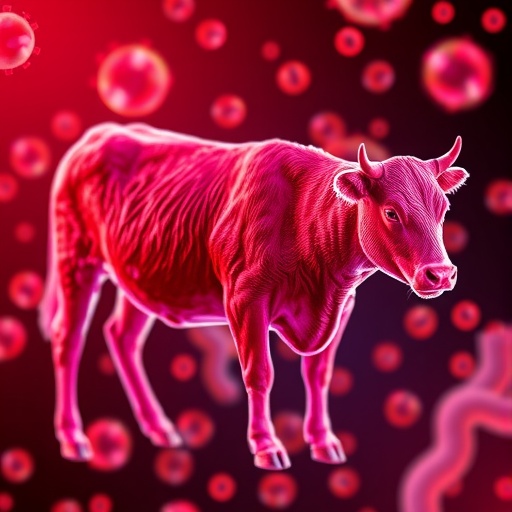Salmonella Dublin, a pathogenic bacterium primarily associated with cattle, has increasingly emerged as a significant public health threat due to its rising resistance to antibiotics. Originating mainly in bovine hosts, certain strains of this microorganism have demonstrated a worrying capacity to adapt and infect humans, causing severe illness and hospitalization. A meticulous study conducted by researchers at Penn State University sheds new light on the genomic evolution of Salmonella Dublin, revealing critical insights into its spread, genetic stability, and the challenges posed by antimicrobial resistance in the United States.
This comprehensive investigation analyzed 2,150 isolates of Salmonella Dublin collected over two decades from 2002 to 2023, sourced from sick cattle, infected humans, and various environmental samples linked to agricultural settings. By leveraging whole-genome sequencing data accessible through national repositories such as the National Center for Biotechnology Information Pathogen Isolate Browser and the National Antimicrobial Resistance Monitoring System, the research team was able to conduct an unprecedented comparative analysis on the genetic makeup of this pathogen across different hosts and environments.
Despite the widely varied origins of the bacterial strains in this study, the results strikingly indicated a high degree of genetic similarity. This genomic conservation among isolates from cattle, humans, and environmental sources underscores the likelihood of cross-species and environmental transmission pathways. Such findings emphasize the interconnectivity of animal health, human health, and ecosystem factors—a concept central to the One Health approach advocated by experts in infectious diseases.
A deeper exploration into the pathogen’s genetic core identified key components responsible for virulence and antimicrobial resistance. Notably, Salmonella Dublin strains derived from cattle exhibited the highest frequency of antimicrobial resistance genes and showed a greater prevalence of multidrug-resistant plasmids—circular DNA elements that can independently propagate and enhance bacterial survival against antibiotic treatments. The heightened genetic diversity amongst bovine strains reflects ongoing evolutionary pressures and adaptation mechanisms within livestock populations exposed to various antimicrobial agents.
These multidrug resistance elements present a clinically significant obstacle, as they can impede effective treatment for both infected cattle and humans. The study’s lead author, postdoctoral scholar Sophia Kenney, highlights the complexity this resistance introduces to managing infections, particularly in settings where humans are exposed to bacteria through contaminated meat products or direct contact with animals on farms. The emergence of multidrug resistance within Salmonella Dublin calls for urgent attention to antibiotic stewardship and surveillance within agricultural systems.
The research further confronts prior limitations in Salmonella Dublin studies which typically concentrated on isolated sources or regional outbreaks. By integrating data across multiple hosts and environmental contexts in the United States, the team was able to provide a dynamic perspective on the pathogen’s evolving landscape. This comprehensive temporal and genomic investigation facilitates a better understanding of the mechanisms underlying pathogen persistence, transmission, and adaptation over time.
According to senior author Erika Ganda, associate professor of food animal microbiomes at Penn State, the findings demand a reevaluation of current control strategies. The strong genetic interconnection across hosts suggests that interventions must transcend traditional species-specific approaches. We must consider a holistic epidemiological strategy that encompasses human healthcare, veterinary medicine, and environmental management to effectively curb the spread of antibiotic-resistant Salmonella Dublin.
The implications of this study extend beyond immediate clinical concerns; they also bear on food safety regulations and public health policies. Contaminated beef, milk, and cheese are well-established vehicles for bacterial transmission to humans, but environmental reservoirs and human-animal contact pathways play significant roles in maintaining and amplifying the bacterial population. Ignoring any link in this transmission chain risks undercutting disease control efforts.
Analytically, the team’s use of whole-genome sequencing allowed detailed comparisons of genetic expression and identification of pathogenicity factors at a granular level. Through these cutting-edge molecular tools, it becomes possible to track the subtle genetic changes that influence virulence, resistance, and fitness. The high resolution genomic data thus serves as a powerful resource in both outbreak investigation and the development of predictive models for pathogen evolution.
This research was made possible in part by funding from the U.S. Department of Agriculture’s National Institute of Food and Agriculture and related federal programs. The collaborative contributions of epidemiologists, bioinformaticians, and microbiologists, including Pennsylvania Department of Health’s lead epidemiologist Nkuchia M’ikanatha, reflect the multidisciplinary effort required to tackle such a complex threat.
Ultimately, this study stands as a vital reminder of the ongoing battle against antibiotic-resistant bacteria, especially those originating in animal agriculture with the potential to impact human health. Improving surveillance infrastructure, promoting responsible antibiotic use, and enhancing cross-sector collaboration will be fundamental to preventing the further emergence and dissemination of formidable pathogens like Salmonella Dublin in the future.
Subject of Research: Animals
Article Title: Genomic evolution of Salmonella Dublin in cattle and humans in the United States
News Publication Date: 19-Aug-2025
Web References:
- U.S. Centers for Disease Control and Prevention: https://www.cdc.gov/narms/cattle-antibiotic-resistance.html
- National Center for Biotechnology Information Pathogen Isolate Browser: https://www.ncbi.nlm.nih.gov/pathogens/
- National Antimicrobial Resistance Monitoring System: https://www.fda.gov/animal-veterinary/antimicrobial-resistance/national-antimicrobial-resistance-monitoring-system
- Published study DOI: http://dx.doi.org/10.1128/aem.00689-25
References: - Kenney, S., Ganda, E., et al. “Genomic evolution of Salmonella Dublin in cattle and humans in the United States,” Applied and Environmental Microbiology, 2025.
Image Credits: Penn State
Keywords: Bacteriology




